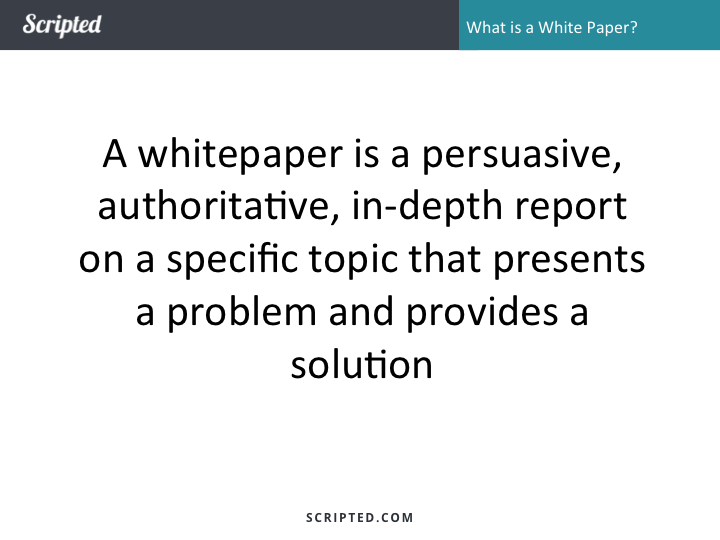- Blog Home
- Content Analytics
- Nicole Karlis
- How To Measure The Roi Of Your White Papers (The Right Way)
How To Measure The ROI of Your White Papers (The Right Way)

Marketers depend on white papers for a variety of reasons -- find out if you're measuring your content goals correctly.
Today's content marketers take on challenges armed with an array of assets -- and they need to be ready at all times for every type of situation. Think of it like a golf bag; no matter what the obstacles are, or how far away the target is, there is ideally a club in the bag that the golfer can succeed with using. From the tee? E-mail campaign. Long fairway shot? Video testimonial. Short chip? Twitter campaign. Long putt on uneven green? Webinar. Tap in? Free demo.
In content marketing, a white paper is just one club in the bag -- but it's a critical one. It won't be used for every shot, but you can't walk the lines without it. A few weeks ago, we hosted a webinar with our friends at DoxIQ to discuss the importance of white papers in marketing (yes, they're still relevant!). Michael Feng, co-founder and CEO of DoxIQ, teamed up with J.D. Peterson, SVP of marketing here at Scripted, and myself to explore the heart of the white paper debate: ROI.
See also: How to Measure the ROI of Your Blog Content
What Is A White Paper?
First off, we wanted to establish what a white paper actually is -- since they've evolved over the years, just like the definition. To put together a succinct explanation, we took a page out of HubSpot's book saying that a white paper is a "persuasive, authoritative, in-depth report on a specific topic that presents a problem and provides a solution."
White papers vary in tone and content depending on where in the funnel they're being deployed. For example, broader and more helpful white papers are typically at the top of the funnel (the awareness stage), more fact- and data-driven are in the middle (research & comparison stage), while more explicitly promotional and product-focused white papers are used at the bottom of the funnel (closing stage). Additional qualities that define a white paper are:
* Includes multiple outside sources
* Can be gated or un-gated
* Typically is a piece of content you have to download to access (whether or not it's gated)
Four Questions To Ask Yourself About White Papers
DoxIQ is focused on reshaping the value of document-based marketing collateral by moving it away from PDFs and onto the web, thereby allowing for dramatically increased ROI made possible by enhanced data collection. After establishing the basics of white papers, Michael introduced the four key questions that must be addressed when considering the efficacy of white papers:
- Are white papers still relevant today?
- Do people actually read white papers?
- To gate or not to gate?
- How do I know if it's working?
At the heart of the answers to these questions is the matter of context -- white papers are not always going to make sense for every campaign. For a long funnel that requires a great deal of nurturing and education, a white paper can be a real asset. A white paper can also be perfect in a situation where there are multiple decision-makers involved, and in which you have both "champions" and "blockers." A white paper can also make sense when engaging with a "traditional" company as opposed to a "new world" one.
Eyeballs or Leads?
During the webinar, Michael presented a great deal of his own company's data to highlight how data collection can inform strategy, with the question of gated content being an ideal example of how this process works. But to decide on a gating strategy, a marketer needs to answer this question first: do you want eyeballs, or leads?
See also: The Future of Content Marketing & Lead-Generation Content
Then he took a look at measurement mechanisms, and again highlighted how web-based documents can offer marketers critical data about engagement, via both high-level metrics like bounce rates, download rates, and share rates, and also at the "person level," where businesses are able to see what happens "after the click."
Later on, J.D. addressed five questions as a simple way to think about measurement, with each question including a set of recommended metrics:
- Is anybody reading it? (To determine, look at consumption stats like views and downloads)
- Is it helpful? (Look at customer feedback, media & influencer coverage, etc.)
- What do people do after they read it? (Multiple reads? Return site visits? Any conversion events?)
- Are people sharing and/or discussing it? (Look particularly at social engagement/sharing)
- Which content is resonating most with buyers? (Consider content scoring systems, and filtering for MQL engagement patterns)
We concluded the presentation with a 30-minute Q&A section.
What do you think about white paper ROI? Join the discussion below.
To Read More About Content Writing Services, See Below:
Why Marketers Should Use Content Writing Services In 2015
Why SEO Experts Are Supporting Original Content Writing
5 Spooky Signs Your Content Team Needs Ghostwriters [SlideShare]

